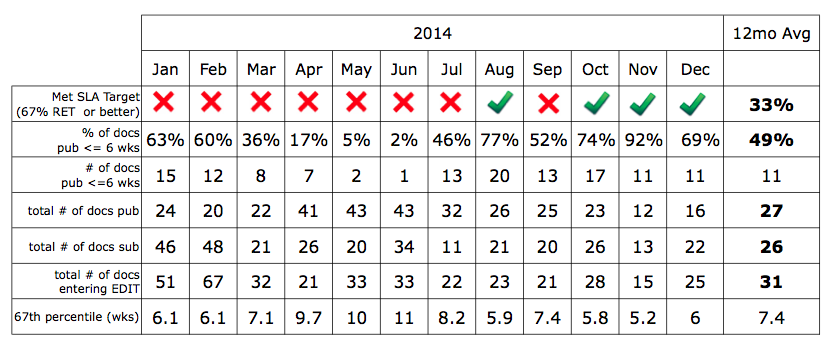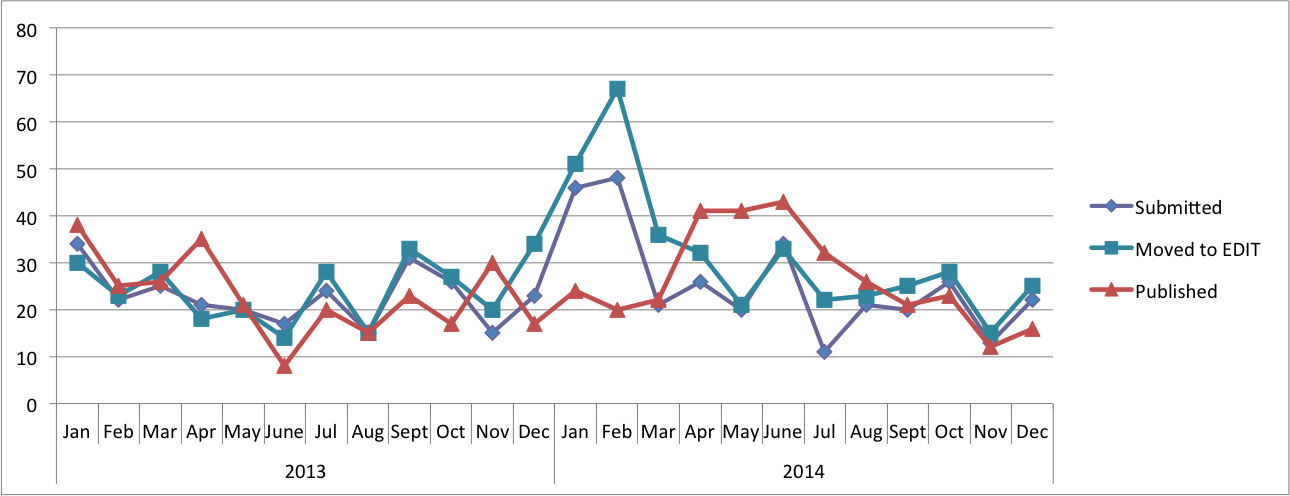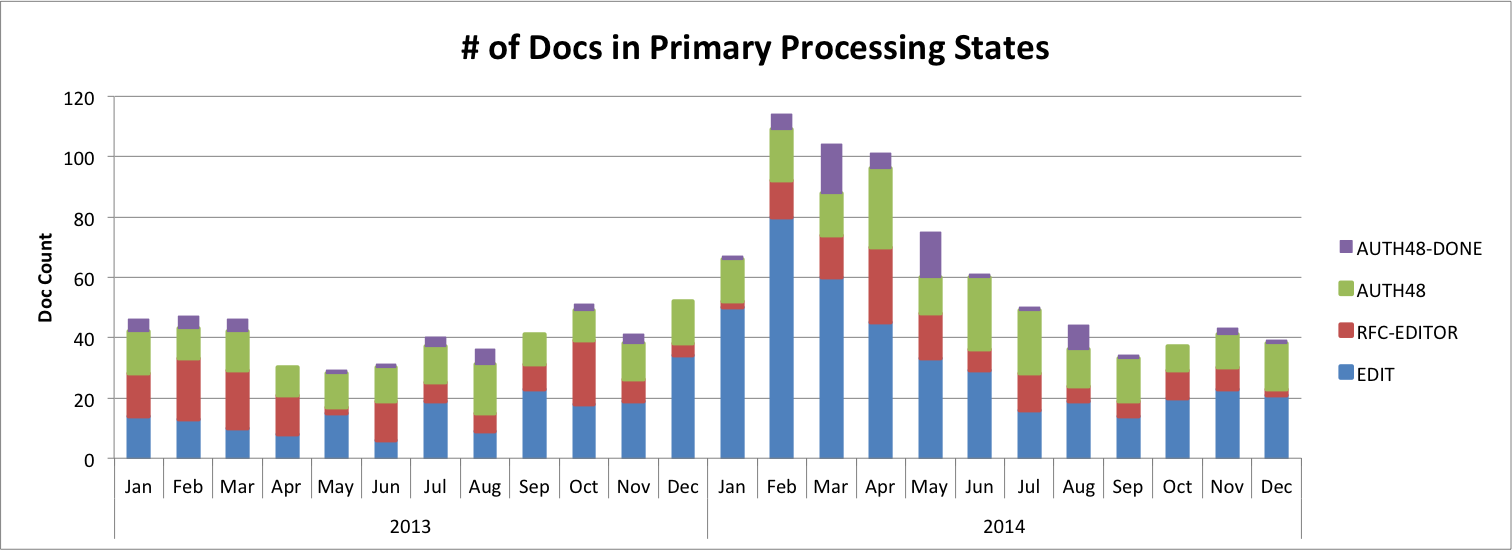
This page contains useful information regarding the performance of the RFC Production Center (RPC). It includes news items (updated as needed) and stats about production that are updated on a monthly basis.
The RFC Editor strives to provide excellent and timely editorial service. To ensure the RFC Editor is providing the best possible service, the RPC regularly reviews its processes and liaises with the communities served. In addition, the rfc-interest mailing list is dedicated to discussing topics related to the RFC Editor.
Table of Contents
The Service Level Agreement indicates that 67% of the documents should be published with an RFC-Editor time (RET) of 6 weeks or less. The following table indicates whether we are meeting this goal. It also includes a running 12-month average. Note that pre-2014 SLA monthly reports are available in the reports archive.

December 2014: Having met the SLA in December, the RPC had a successful Q4. The table shows the impact of the increased number of documents entering the queue (both newly approved and those released from MISSREF) earlier in the year, and the RPC's recovery throughout the remainder of the year.
November 2014: November was a slow month in terms of submissions and publications. We expect this is largely due to IETF 91, which took place in early November. The RPC invested a significant amount of time preparing to host the Experimental Writing Lab and reviewing the individual documents to be discussed with the authors that requested a session.
The RPC responded to one legal inquiry; see iaoc.ietf.org/subpoenas.html
October 2014: The RFC Editor is gearing up for IETF 91 in Honolulu, Hawaii. As part of this preparation, we have built the framework for hosting Experimental Writing Lab sessions at IETF 91.
September 2014: The RFC Editor published the new RFC Style Guide (RFC 7322) and the Web Portion of the Style Guide. We have successfully transitioned documents in the queue to meet the recommendations defined therein (see the announcement for detailed information). The RFC Editor also released an updated Style Guide page, which includes additional information and guidance to authors.
August 2014: The RPC has successfully worked through the bursts of documents that entered EDIT in the first quarter of this year and is once again meeting the SLA.
The RPC responded to one subpoena; see iaoc.ietf.org/subpoenas.html
July 2014: The RPC is continuing to make progress with the queue, both in terms of the number of documents in the queue and the SLA times. In addition, staff continued to train its newest editor, to work with the RSE to get the new Style Guide published and provide input on various discussions (e.g., RFC design, SoWs for tools), and to prepare for various IETF 90 activities (e.g., reports and tutorials).
The RPC responded to one subpoena; see iaoc.ietf.org/subpoenas.html
June 2014: The RPC is making significant inroads in bringing the queue down. The RPC also processed some large clusters this month (e.g., httpbis), which resulted in higher than normal processing times.
While processing times have been high, the graphs below show that the overall queue is decreasing in size and is becoming more manageable. The RPC continues to work through the current queue, and at the same time continues to train its newest editor. In addition, staff is working with the RSE to get the new Style Guide published and provide input on various discussion (e.g., RFC design, SoWs for tools).
The RPC responded to one subpoena; see iaoc.ietf.org/subpoenas.html
May 2014: Thanks to the additional support from the IAOC to work through the recent burst of submissions, we have a new editor that started working with the RPC in May. In addition to processing documents, the RPC has updated their procedures and invested in the training of their newest editor.
The RPC responded to one subpoena; see iaoc.ietf.org/subpoenas.html
April 2014: The RFC Editor did not meet the SLA target for the fourth month in a row. The 67th percentile indicates that we are just short of hitting the 6-week goal.
By this time of year, we would normally be seeing a slow down in documents moving into EDIT, after the submission burst associated with the IESG turnover. However, that slow period has not yet started, as we've seen an average (or even slightly high) number of documents move to EDIT in March and April (36 in March and 32 in April). 52% of the documents submitted for publication in 2013 have already been approved for publication in the first 4 months of 2014. This number is even higher for documents that have moved to EDIT; see the notes under "Monthly Submission and Publication Stats." The RPC continues to work hard to reduce the queue size and processing time in RFC Editor states.
The RPC responded to one subpoena; see iaoc.ietf.org/subpoenas.html
March 2014: As mentioned previously, the RFC Production Center continues to work through the surge of documents released into EDIT earlier this year. While the RPC did not meet the SLA in March, the target is being met on an annual scale.
February 2014: The January issues listed below continue to be a factor. In addition, 67 documents were released into the EDIT queue this month. This means 118 documents have entered the EDIT queue in the first 2 months of the year. This is a significant number, as it means 43% of all documents published in 2013 have already entered the EDIT queue this year.
While the RPC did not meet the SLA in February, the target was not missed by much, as 67% of RFCs have an RET time of 6.1 weeks. The RPC continues to meet the SLA on an annual scale.
The RPC responded to three subpoenas; see iaoc.ietf.org/subpoenas.html
January 2014:The RFC Editor did not meet the SLA target. There are a few exceptional factors that contributed to processing delays:
While the RPC did not meet the SLA in January, the target was not missed by much, as 67% of RFCs have an RET time of 6.1 weeks. The RPC continues to meet the SLA on an annual scale.
The following figures show the recent submission and publication rates. The figures also include "moved to EDIT", which provides a more accurate picture of the RPC's incoming workload for a given month. "moved to EDIT" refers to documents that were released into the EDIT state.
Detailed submission and publication data can be found on the Comprehensive Sub/Pub Stats page.

Notes
November & December 2014: This graph shows the rate of documents entering and exiting the queue over the last 24 months. We see that there was a spike of documents entering EDIT in January, with increased publication rates in April - June. The publication rates were down in November and December, as we often see a slower response times between authors and editors, as many are on vacation during the winter holidays.
October 2014: There was a slight increase in submissions this month, as compared to the last few months.
August and September 2014: The RPC published slightly more RFCs than the number that were released into the EDIT queue, resulting in a further reduction in the total number of documents in the queue.
July 2014: The RPC had another sizable publication month, so the queue size has continued to decrease.
June 2014: The last three months have been big publication months. As can be seen, the size of the overall queue and the number of documents in EDIT continues to decrease. The decrease in queue size indicates that the RPC is working through the queue.
May 2014: April and May have been big publication months. We have seen a steady decline in the number of documents moving to EDIT since February. The increase in publications is an indication that the RPC is starting to work its way through the burst of documents that entered the queue earlier this year.
April 2014: The graph shows that, while submissions are down, the number of documents entering EDIT has not slowed as is typical post IESG changeover. 64% of the documents that moved into EDIT in 2013 have already been released to EDIT in the first 4 months of 2014.
March 2014: The submission rates and the number of documents released into edit in the first quarter of 2014 have been extremely high. See the notes under the SLA report for details.
November and December 2013: A flurry of high-page-count documents were released from MISSREF, and (as noted above) expedited processing was requested for one of the large clusters, impacting the production times of the other documents in the queue.
Summary of queue statistics about the processing times of documents as they move through the RFC Editor queue are available on the Queue Summary page. The summary includes document counts, page counts, and average times in queue per state (EDIT, RFC-EDITOR, AUTH48, and AUTH48-DONE). See state definitions for help understanding the states.
The number of documents in the primary processing states at the end of a given month is shown in the figures below.

Note that there is a ripple effect, as spikes in document counts in any one state may be due to clusters of documents moving through the queue together. A cluster does not move to the next state until the entire set is ready to be moved. You will often see bursts in EDIT, then RFC-EDITOR, and finally PUB, as the set of documents move through the states together to publication.
Generally speaking, the more documents there are in the queue, the longer it takes for documents to move through the queue.
Notes
December 2014: The majority of documents in the queue are in the EDIT and AUTH48 states. A few clusters were released into the EDIT queue, including a 300+ page NFS document, which is part of C182.
November 2014: Because of the time the RPC invested in preparing for IETF and for the Experimental Writing Lab sessions, we saw a slight increase in the EDIT queue this month.
October 2014: With the slightly increased submission rates noted above, the EDIT queue has increased slightly as well.
August and September 2014: As can be seen in the graph, the RPC has continued to work its way through the huge surge experienced earlier this year, which cuts the queue size by more than 50% from its peak in February.
July 2014: As can be seen in the graph, the RPC has continued to work its way through the huge surge experienced earlier this year. The queue size has continuously declined since its peak in February.
June 2014: The number of documents submitted to the queue and entering EDIT since December 2013 have remained high. While May was a low submission month, submission numbers were again high in June. The RPC is starting to make headway in to the queue, as we see the third big publication month in a row.
May 2014: This figure shows that, since February, there has a steady decline in the number of documents in EDIT and the overall queue.
April 2014: The figure shows that the number of documents in EDIT has gone down consistently in March and April. The number of documents in RFC-EDITOR and AUTH48 has grown, which is largely due to the clusters currently in these states (i.e., most of C160 in RFC EDITOR, and the following clusters in AUTH48: a portion of C160, as well as C199, C203, C218, C222).
March 2014: A number of documents are being held in AUTH48-DONE because of the clusters. As cluster documents are approved for publication, they are moved to AUTH48-DONE and (typically) held until the entire cluster of documents has been approved. Once the cluster has been approved, we announce all of the documents in the cluster.
| Report | Description |
|---|
| Current Queue (sortable) | A list of all of the documents in the RFC Editor queue, ordered by state. (Updated dynamically) |
| State Changes by Month | Summary of document movement through the RFC Editor queue. (Updated weekly) |
| Annual Publication Rate | Bar graph showing the number of RFCs published per year since 1969. (Updated annually). |
| RFC Editor Reports at IETF | Summary of the RFC publication process, including the state of the queue and a breakdown of the reasons for any long delays in the publication process. The report also may include recent changes in policy and improvements in tools or procedures. (Updated quarterly) |
| RFC Errata Reports | Summary of errata reports and their status, stream, and type. (Updated quarterly) |
| Vendor Reports | Links to performance reports, e.g., 2013 performance review of the RPC. (Updated annually) |
| RFC Status Changes (post publication) | List of the RFCs whose statuses have changed since publication. (Updated as needed) |